

3/11/2017 Hypoxia-Dependent Epigenetic Modifications in the Pulmonary I have no financial disclosures or Vasculature conflicts of interest Sheila Krishnan, D.O. 10th International Conference Neonatal & Childhood Pulmonary Vascular Disease San Francisco, CA March 11, 2017 Divergent and Reversible Postnatal Significance of High Altitude Pulmonary Pulmonary Vascular Remodeling in Hypertension High Altitude vs. Sea Level • HAPH is a designated subset of PH under the group III clinical classification (PH due to lung disease/hypoxemia) • Estimated that 140 million people reside at high altitude (>8200 feet above sea level) and 40 million temporary visitors to mountains • Pathology involves hypoxia-driven pulmonary artery smooth muscle cell proliferation that is reversible upon descent to sea level D Penaloza, et al. Circ 2007 P Bartsch, et al. NEJM 2013 F Sime, et al. Brit Heart J 1971 1
3/11/2017 Augmented Vasoreactivity in Adult Life Peri and Postnatal Events in PH Associated with Perinatal Vascular Insult Risk Factors * ☨ • Genetic • Environmental • Endogenous Fetus Child Adult TIME Derived from E Austin, et al. Ann Am Thorac Soc 2014 C Sartori, et al. Lancet 1999 Epigenetic Induction of Pulmonary Vascular Significance of Epigenetics and PH Dysfunction is Reversible through Modification of the In Utero Environment • Epigenetics: refers to changes in gene expression that do not involve changes in the DNA sequence – Change in phenotype without change in genotype • Epigenetic changes in mitochondrial metabolism and histone acetylation have been linked to vascular pathology in PH development in animal models SL Archer, et al. Circ 2010 # p=0.002 vs. controls ✻ p=0.02 vs. controls L Zhao, et al. Circ 2012 ⍺ p=0.009 vs. diet + vehicle E Rexhaj, et al. Am J Physiol Heart Circ Physiol 2011 2
3/11/2017 Differentially Methylated Genes in Peripheral Blood of High Altitude vs. Low Altitude Infants Research Questions Green : hypomethylated Low Altitude n=10 High Altitude n=10 • Do epigenetic modifications play a role in the (upregulated) genes adaptive response to chronic hypoxia? Red : hypermethylated (downregulated) genes • If so, what pathways are involved and how Hypomethylated pathways/genes •Lung differentiation (NFATc1) early in life do these modifications begin? •VEGF signaling (SEMA3A) S. Krishnan, et al. Am J Respir Crit Care Med 193;2016:A7841 Research Design Hypotheses • Epigenetic changes play a role in the developmental adaptive response to chronic hypoxia Breeding pair in Hypoxia hypobaric hypoxia Hypoxia • Chronic hypoxia in utero stimulates epigenetic modifications of In-utero (FiO2=15%; equiv to Post-natal 9,000 ft altitude) hypoxia-sensitive pathways that provide developmental adaptive processes in the cardiopulmonary system and minimize HAPH • The epigenetic modifications that occur in utero are inducible and reversible when the post utero environment is changed Breeding pair Room air Room air in normoxia In-utero Post-natal • Responses to chronic hypoxia differ between males and females 3
3/11/2017 Datapoints Simulated High Altitude Exposure is Associated with Increased Diffusing Capacities at 6 wks of age • Post natal day 1: p=0.028 • Lung and vascular structure 0.15 • DNA-epigenetic analysis: peripheral blood, lung, heart, skeletal muscle • 0.10 6 weeks: DLCO • Lung volumes • Diffusing capacity 0.05 • Right ventricular thickness p=0.0127 • Cardiac output • Hemodynamics 0.00 male female male female • Pulmonary artery structure • DNA-epigenetic analysis: peripheral blood, lung, heart, skeletal muscle RA-RA H-H Simulated High Altitude Exposure is Associated Simulated High Altitude Exposure is Associated with Increased Functional Residual Capacity at 6 wks of age with Increased RV Cardiac Output in Males at 6 wks of age p=0.007 0.020 2.0 p=0.0475 0.015 FRC/weight 1.5 RV CO/weight 0.010 1.0 0.005 0.5 0.000 0.0 male female male female male female male female RA-RA H-H H-H RA-RA 4
3/11/2017 Summary Simulated High Altitude Exposure is Associated with Increased RV Mass in Males at 6 wks of age • Preliminary data indicates there is a HAPH phenotype at 15% FiO2 0.5 • Males seem to have a more distinct phenotype compared to females, suggesting p=0.0019 0.4 that sex hormones may play a role RV/LV+septum 0.3 • Next Steps: – Perform epigenetic analyses on tissue from RA-RA and H-H groups 0.2 – Perform cross-over study for RA-H and H-RA groups 0.1 0.0 male female male female RA-RA H-H THANK YOU Mentors: Funding: Tim Lahm, M.D. PHA - Cordelia's Pediatric PH Research and Mentoring Grant Rob Tepper, M.D, Ph.D. T32 Training Program in Lab Members: Molecular Physiology and Clinical Yong Gao Mechanisms of Lung Disease, Amanda Fischer Indiana University Margie Albrecht Andrea Frump, Ph.D. 5
Recommend
More recommend